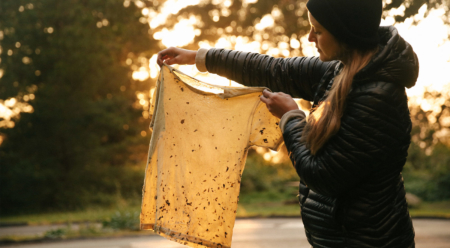Experimenting with Naturally Dyed Clothing
Forty-five years ago, the old school North American outdoor uniform was basically colored in khaki, denim blue and olive green. Not only were the colors monotonous, but the dyes used were mostly petroleum based. Imagine no Craft Pink as vivid as the beavertail cactus flower. No Galah Green as bright as the waters off the coast of Belize. Or Sporty Orange inspired by a Haleakalā sunset. Patagonia changed all that with the introduction of the Rugby Shirt back in the ’70s. Not only was it suitable for big wall climbing, it was offered in colored stripes that boasted primaries as bold as the lines Yvon Chouinard and friends were putting up on polished granite walls.
Today, Patagonia is taking another leap into the unknown by choosing to use colors found in nature while adhering to their mission statement to “cause no unnecessary harm.” This means not only looking deeper into nature’s color palette for inspiration, but experimenting with natural dyes.
“We use the mission statement as a filter and take a holistic approach to developing every material, looking at fiber origin, fiber processing, knitting/weaving of fabrics, dyeing/finishing, as well as the supply chain partners involved in every step of the process,” explains Sarah Hayes, Patagonia’s Senior Material and Research Innovation Manager.

On a winter climbing trip to Scotland in 1970, Patagonia founder Yvon Chouinard bought a regulation team rugby shirt thinking it would be great for rock climbing. Photo: John Russell
The company’s new Clean Color collection is a result of trying to cause less harm. “Using eco-friendly dyes is a key area of focus right now as, traditionally, it’s a water-intensive process and can involve chemicals Patagonia wants to avoid,” Hayes says. The World Bank estimates that 20 percent of global water pollution is caused by textile processing, and Chemical & Engineering News reports that the textile industry uses more than 8,000 chemicals, including bleaches (think chlorine), detergents, solvents (from petroleum-based mineral spirits, classified as an emitter of VOCs, to organic solvents like trichloroethane) and heavy-metal-rich dyes and fixing agents, to make the 400 billion cubic meters of fabric sold globally each year.
Julia Seltzer, Patagonia’s Global Senior Marketing Manager, Sportswear, sees an alternative—and brighter—future for the textile industry. “We are constantly trying to push forward the conversation around radical eco-innovation at Patagonia,” Seltzer says. “With the launch of Clean Color, we are following up on another dye initiative—denim being dyed with nontoxic dyes and made of organic cotton (because denim is a filthy business!).” In Fall 2015, Patagonia introduced advanced denim that uses 84 percent less water, 30 percent less energy and emits 25 percent less CO2 than conventional synthetic indigo dyeing.
The Clean Color collection represents the next step in Patagonia’s journey to change the industry. “Each season, we work on finding new ways to minimize our environmental footprint,” Hayes says. “Most of the time, it’s not an easy route.” (But then neither were Yvon Chouinard’s early ascents in Yosemite or his first experiments with making climbing chocks.) “We often introduce these innovations in smaller, ‘direct’ collections, as they are experiments,” Seltzer explains. “Ideally, we then apply them to our entire line, like we did with recycled wool.”
It took Hayes and her team close to three years to find, test and bring the dyes for the Clean Color collection to market. “Sarah and her team invested a lot of time and research in finding petroleum-free dyes that meet our quality standards,” Seltzer says. The process began with Patagonia intern, Hunter Hendrick, working closely with Hayes and Courtney Merritt, Senior Material Manager, to do a deep research dive on the pros and cons of natural dyes and identify opportunities within the existing supply chain—and beyond—to commercialize. Next, the project moved to the regular team of Hayes and Merritt plus Laura Tripp, Material Developer, Knits, and Alli Lapierre, Testing and Standards Engineer, to focus development with a specific supply chain partner, select material and dye combinations, facilitate wear test samples and measure environmental impacts.
The Clean Color collection includes both natural and biosynthetic dyes comprised of 96 percent renewable resources (primarily agricultural waste). “Earthcolors by Archroma® is a similar dye platform to our advanced denim,” Hayes says, adding that these dyes perform like their synthetic, sulphur dyeclass counterparts, in the ways in which they affix to a textile, allowing it to wash down, creating a beautiful, faded color effect.
The dyes themselves are a blend of ancient techniques and modern technology. For example, powdered cochineal beetles are the basis of the rosy color in Patagonia’s Clean Carmine Pink. The cochineal beetle (Dactylopius coccus) is technically not a beetle with wings and legs, it’s a scale insect that feeds on prickly pear cactus and is found primarily in Central and South America. The red color comes from the bodies of the females, which contain carminic acid to repel predators. In fact, carmine was once so valuable that the Aztec Emperor Montezuma levied a special tax on his subjects that was paid in these prized insects.
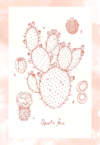
A. Prickly pear cactus. B. Mature fruit. C. Flower and immature fruit. D. Detail of mature seeds. F. Cochineal Beetle. Illustration: Sean Edgerton
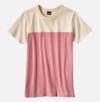
Women’s Clean Color Block Tee in Clean Carmine Pink.
Herbal product waste is the source for the richly hued Clean Palmetto Green and Clean Citrus Brown colors. While materials from palmetto trees can serve as wharf pilings and scrubbing brushes, and the buds are really tasty as hearts of palm in salads, the Clean Palmetto Green dye comes from herbal industry byproducts. And the Clean Citrus Brown dye comes from the production residue of the herbal remedy called bitter orange peel.
Food waste, namely the rinds of pomegranates, which are native from Iran to the Himalayas in northern India, is the basis for the warm Clean Pomegranate Grey. Pomegranate rinds yield a rich yellow brown that was once used to dye leather; the grey dyes are produced from the byproducts of fruit used in food production.
And since plants that yield green dyes are rare (who knew?), Patagonia is using Chinese silkworm excrement—its rich green comes from the insects’ diet of fresh mulberry leaves—as the foundation for the development of the Clean Mulberry Green dye.
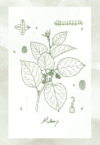
A. White mulberry branch. B. Female fruit. C. Male fruit. D. Female flower. E. Male flower. F. Silkworm. Illustration: Sean Edgerton
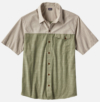
Men’s Clean Color Short-Sleeved Shirt in Clean Mulberry Green.
With any new technology, there are a lot of learning curves. “Despite comprehensive testing and working with progressive suppliers, unexpected challenges arise,” Seltzer says. Hayes agrees, adding that natural dyes, in particular, can experience colorfastness challenges and will fade differently than their synthetic counterparts. In fact, Patagonia pulled one color from the collection due to this challenge. “We learned that one of the colors experienced an unexpected reaction with ozone (oxidation) and have started exploring how to mitigate the problem,” Seltzer says.
Caring for Clean Color clothing is pretty simple: machine wash in cold water on the gentle cycle with similar colors, use mild detergents, and iron on low. Don’t bleach or dry clean, and be aware that natural dyes may fade gently over time or in direct sunlight.
In addition to using natural dyes, all Clean Color clothing styles are made with organic cotton or a blend of organic cotton and synthetics. The Men’s Clean Color Jacket and Pants and Men’s and Women’s Clean Color Shorts are also sewn in a Fair Trade Certified™ facility.
Will Patagonia continue to work with natural dyes in the future? Absolutely. “We won’t stop exploring alternative solutions to synthetic dyes, as they are one of the worst toxic water pollutants,” Seltzer says. Hayes adds that the company is constantly vetting new technologies and is already actively working on the next generation of dyes. Patagonia’s goal is to encourage other companies to follow suit. “We are hoping that more and more brands will join us in this experiment in order to find new ways of making apparel more sustainable,” Seltzer says.
This story was commissioned by Patagonia. Visit patagonia.com to see the entire Clean Color collection.
